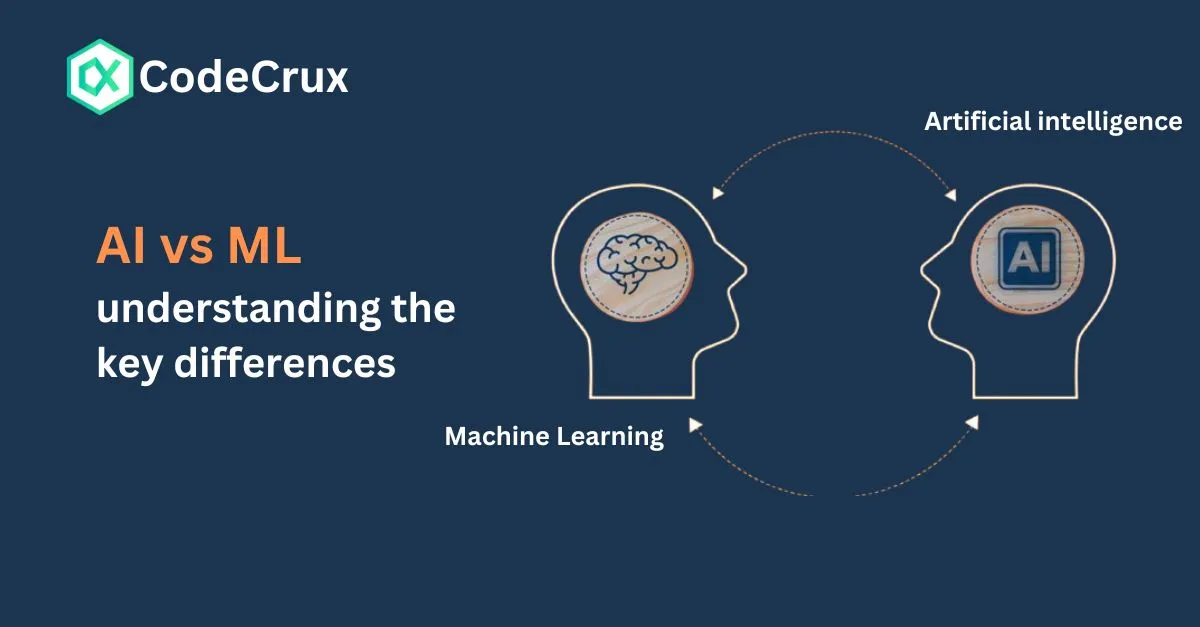AI vs ML understanding the key differences

In the rapidly evolving world of technology, Artificial Intelligence (AI) and Machine Learning (ML) are two buzzwords often used interchangeably. However, they represent distinct concepts with unique applications and characteristics. This blog will break down the differences, relationships, and real-world implications of AI and ML to provide clarity.
What is Artificial Intelligence (AI)?
Artificial Intelligence is a broad field of computer science aimed at creating systems that can perform tasks requiring human intelligence. AI involves mimicking cognitive functions such as problem-solving, reasoning, perception, and language understanding.
Key Features of AI:
- Goal-Oriented: Designed to solve specific problems or perform tasks.
- Wide Scope: Encompasses various technologies, including ML, robotics, natural language processing (NLP), and expert systems.
- Autonomy: Can operate independently by adapting to changing environments.
Types of AI:
- Narrow AI: Focused on a single task (e.g., virtual assistants like Siri).
- General AI: Hypothetical AI that can perform any intellectual task a human can (still under research).
- Super AI: Theoretical AI that surpasses human intelligence (a long-term goal).
What is Machine Learning (ML)?
Machine Learning is a subset of AI that enables systems to learn and improve from experience without explicit programming. It uses algorithms and statistical models to analyze data, identify patterns, and make predictions or decisions.
Key Features of ML:
- Data-Driven: Relies on large datasets for training and improvement.
- Adaptability: Continuously refines its accuracy based on new data.
- Automation: Reduces the need for manual intervention in repetitive tasks.
Types of ML:
- Supervised Learning: Learns from labeled datasets (e.g., spam email detection).
- Unsupervised Learning: Identifies patterns in unlabeled data (e.g., customer segmentation).
- Reinforcement Learning: Learns through rewards and punishments (e.g., autonomous vehicles).
Key Differences Between AI and ML
Aspect
Artificial Intelligence (AI)
Machine Learning (ML)
Definition
Simulates human intelligence in machines.
Focuses on systems learning from data.
Scope
Broad, includes ML, robotics, NLP, etc.
Narrow, a subset of AI.
Goal
Solve complex tasks requiring human-like intelligence.
Improve performance through learning.
Dependence on Data
May use ML or rule-based systems.
Relies heavily on data for training.
Applications
Self-driving cars, virtual assistants, healthcare diagnostics.
Fraud detection, recommendation systems, dynamic pricing.
The Relationship Between AI and ML
- AI is the umbrella term, while ML is a critical component within this domain.
- ML algorithms are tools that enable AI systems to “learn” and improve their performance over time.
- In simpler terms, AI is the goal, and ML is one of the methods to achieve it.
Real-World Applications
AI in Action:
- Healthcare: AI-powered systems can diagnose diseases like cancer by analyzing medical images.
- Finance: Fraud detection systems use AI to analyze irregular transaction patterns.
ML in Action:
- E-commerce: Personalized product recommendations on platforms like Amazon.
- Transportation: Predictive maintenance in vehicles using ML algorithms.
Conclusion
While Artificial Intelligence and Machine Learning are closely related, they serve different purposes and operate at different levels of abstraction. AI is about building systems that can perform intelligent tasks, while ML is a way of achieving that intelligence by allowing machines to learn from data.
Understanding these differences is crucial for leveraging their potential effectively in various industries. As AI and ML continue to evolve, their combined impact will shape the future of technology and innovation.